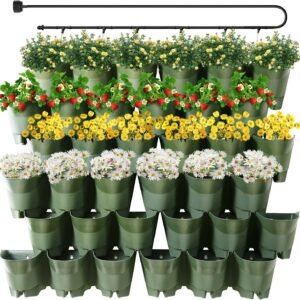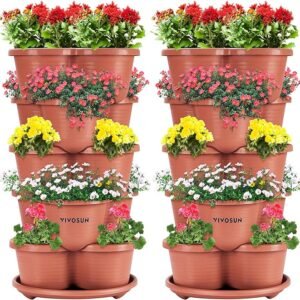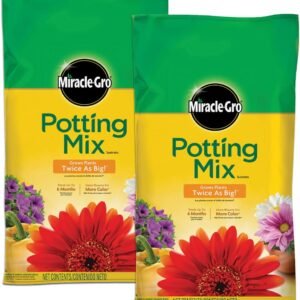Lettuce is a versatile, nutritious, and easy-to-grow vegetable that thrives in container gardens. A lettuce container garden is a fantastic option ,whether you have limited space, want to keep your greens closer to the kitchen, or simply enjoy the convenience of homegrown produce. Not only does it offer a fresh supply of crisp, flavorful leaves for salads and sandwiches, but it also adds a touch of greenery to balconies, patios, or even window sills.
Table of Contents
Here’s a comprehensive guide to help you create and maintain your own thriving lettuce container garden:
1. Selecting the Right Container
The first step is choosing the containers for your lettuce. Here are a few key points to consider:
- Size: Opt for containers that are at least 6-8 inches deep. This provides ample space for lettuce roots to grow.
- Drainage: Ensure containers have drainage holes to prevent waterlogging, which can lead to root rot.
- Material: Options include plastic, ceramic, terracotta, or wooden containers. Each has its pros and cons, so choose based on your preference and climate.
-
 Mr. Stacky 5 Tier Stackable Strawberry, Herb, Flower, Vegetable vertical Planter$31.29
Mr. Stacky 5 Tier Stackable Strawberry, Herb, Flower, Vegetable vertical Planter$31.29 -
 Homdox 4FT Vertical Garden Bed, 5 Tiers Vertical Raised Garden Planter with 4 Hooks$97.95
Homdox 4FT Vertical Garden Bed, 5 Tiers Vertical Raised Garden Planter with 4 Hooks$97.95 -
 Worth Garden 36 Pockets Self Watering Vertical Planters Indoor Outdoor$101.99
Worth Garden 36 Pockets Self Watering Vertical Planters Indoor Outdoor$101.99 -
 3 Tier Stackable Garden – Indoor / Outdoor Vertical Planter Set$24.22
3 Tier Stackable Garden – Indoor / Outdoor Vertical Planter Set$24.22 -
 VIVOSUN 2-Pack 5 Tier Vertical Gardening Stackable Planter$71.69
VIVOSUN 2-Pack 5 Tier Vertical Gardening Stackable Planter$71.69 -
 MEIWO 7 Pocket Hanging Planter for Outdoor Plants, 1 Pack Vertical Wall Planter$16.14
MEIWO 7 Pocket Hanging Planter for Outdoor Plants, 1 Pack Vertical Wall Planter$16.14
You might also like : Top 10 Container Gardening Ideas
2. Choosing Lettuce Varieties
There are numerous lettuce varieties, each offering different flavors, colors, and textures. Some popular choices for container gardens include:
- Leaf Lettuce: Varieties like Red Leaf, Green Leaf, or Oak Leaf are prolific and perfect for continuous harvesting.
- Romaine Lettuce: Known for its crunchy texture and sweet flavor, it’s a classic choice.
- Butterhead Lettuce: Varieties such as Bibb or Buttercrunch have tender leaves and a mild, buttery taste.
- Mesclun Mixes: These blends offer a mix of flavors and textures in one planting.

3. Soil and Planting
- Potting Mix: Use a high-quality potting mix that is well-draining and rich in organic matter.
- Planting: Fill your containers with the potting mix, leaving about an inch from the top. Plant lettuce seeds or seedlings according to the packet instructions, usually around 6 inches apart.
- Depth: For seeds, plant them at a depth of about 1/4 to 1/2 inch.
4. Placement and Sunlight
- Light: Lettuce thrives in partial shade to full sun. Place your containers where they’ll receive at least 6 hours of sunlight per day.
- Temperature: Ideal lettuce-growing temperatures range between 45°F to 75°F (7°C to 24°C).
5. Watering and Maintenance
- Watering: Keep the soil consistently moist, but not waterlogged. Water the containers when the top inch of soil feels dry to the touch.
- Fertilizing: Lettuce is a light feeder, but you can use a balanced, water-soluble fertilizer every few weeks.
- Thinning: If your lettuce is overcrowded, thin out seedlings to ensure proper spacing for mature plants.
- Pests and Diseases: Keep an eye out for common pests like aphids or slugs. Neem oil or insecticidal soap can help manage infestations.
6. Harvesting Your Lettuce

- Leaf Lettuce: Begin harvesting outer leaves when they reach a desirable size, leaving the center leaves to continue growing.
- Romaine and Butterhead: Harvest the entire head by cutting it at the base. It will regrow new leaves if conditions are right.
- Mesclun Mixes: Harvest by snipping leaves with scissors, allowing the plants to regrow.
7. Succession Planting
To enjoy a continuous harvest throughout the growing season, consider succession planting. Every few weeks, plant new seeds or seedlings to replace harvested lettuce. This practice ensures a steady supply of fresh greens for your salads and meals. If you’re looking for high-quality seeds for your next planting, I recommend checking out these organic lettuce seed varieties from [Amazon]. These seeds have been proven to yield delicious, crisp lettuce that’s perfect for your home garden. Happy planting! 🌱
8. Overwintering
- Lettuce can be grown through the cooler months with proper protection.
- Consider using row covers, cold frames, or moving containers indoors near a sunny window to extend the growing season.
9. Creative Container Ideas
- Hanging Baskets: Ideal for small spaces, hang baskets filled with lettuce for a cascading display.
- Vertical Gardens: Utilize vertical space with wall-mounted planters or a vertical tower planter.
- Window Boxes: Line your windowsills with shallow containers for easy access to fresh lettuce.
By following these steps, you can cultivate a bountiful lettuce container garden, providing a steady supply of fresh greens for your culinary creations. Whether you’re a seasoned gardener or just starting, the simplicity and rewards of growing lettuce in containers make it a delightful addition to any home garden. Enjoy the process, experiment with different varieties, and savor the flavor of homegrown goodness!
Frequently Asked Questions (FAQ) About Lettuce Container Gardens
- 1. How much sunlight does my lettuce container garden need?
Answer: Lettuce thrives in partial shade to full sun. Aim for at least 6 hours of sunlight per day for optimal growth. In hotter climates, some shade during the hottest parts of the day can help prevent wilting.
- 2. Can I grow lettuce indoors in a container?
Answer: Yes! Lettuce can be successfully grown indoors in containers. Choose a well-lit spot, such as a sunny windowsill or under grow lights, and ensure proper watering and ventilation.
- 3. How often should I water my lettuce container garden?
Answer: Keep the soil consistently moist, but not waterlogged. Water when the top inch of soil feels dry to the touch. In hot weather, you may need to water more frequently.
- 4. What is the best type of container for growing lettuce?
Answer: Choose containers that are at least 6-8 inches deep with drainage holes to prevent waterlogging. Options include plastic, ceramic, terracotta, or wooden containers, depending on your preference and climate.
- 5. Can I reuse the soil from my lettuce container for the next planting?
Answer: It’s best to refresh the soil for each new planting to ensure your lettuce receives proper nutrients. You can mix used potting soil with compost for a nutrient-rich mix.
- 6. How long does it take for lettuce to grow from seed to harvest?
Answer: Depending on the variety, lettuce can be ready for harvest in as little as 30 days for baby greens or up to 70 days for full heads. Leaf lettuce can often be harvested continuously as it grows.
- 7. What are some common pests and diseases that affect lettuce?
Answer: Common pests include aphids, slugs, and caterpillars. Diseases such as powdery mildew and downy mildew can also occur. Regularly inspect your plants and treat with organic remedies like neem oil or insecticidal soap if needed.
- 8. Can I grow lettuce year-round in a container garden?
Answer: With proper care and attention to temperature, you can grow lettuce year-round in many climates. Consider using row covers or cold frames in cooler months, or move containers indoors near a sunny window.
- 9. How do I know when it’s time to harvest my lettuce?
Answer: For leaf lettuce, start harvesting outer leaves when they reach a desirable size, leaving the center leaves to continue growing. For romaine and butterhead lettuce, harvest the entire head by cutting it at the base. Mesclun mixes can be harvested by snipping leaves with scissors.
- 10. Can I grow other vegetables or herbs in the same container as lettuce?
Answer: Yes! Lettuce pairs well with many companion plants such as radishes, herbs like basil or cilantro, and even small peppers. Just ensure that the plants have similar sunlight and watering needs.
- 11. How do I prevent my lettuce from bolting (going to seed) too quickly?
Answer: To prevent bolting, which can happen in hot weather, provide shade during the hottest parts of the day, keep the soil consistently moist, and choose heat-resistant varieties. Harvesting regularly also helps delay bolting.
- 12. Can I fertilize my lettuce container garden, and if so, how often?
Answer: Lettuce is a light feeder, so avoid heavy fertilization. Use a balanced, water-soluble fertilizer every few weeks, or opt for organic options like compost tea to provide essential nutrients.
With these frequently asked questions answered, you’ll be well-equipped to start and maintain a successful lettuce container garden. Enjoy the fresh, crisp greens right at your fingertips for salads, sandwiches, and more!






